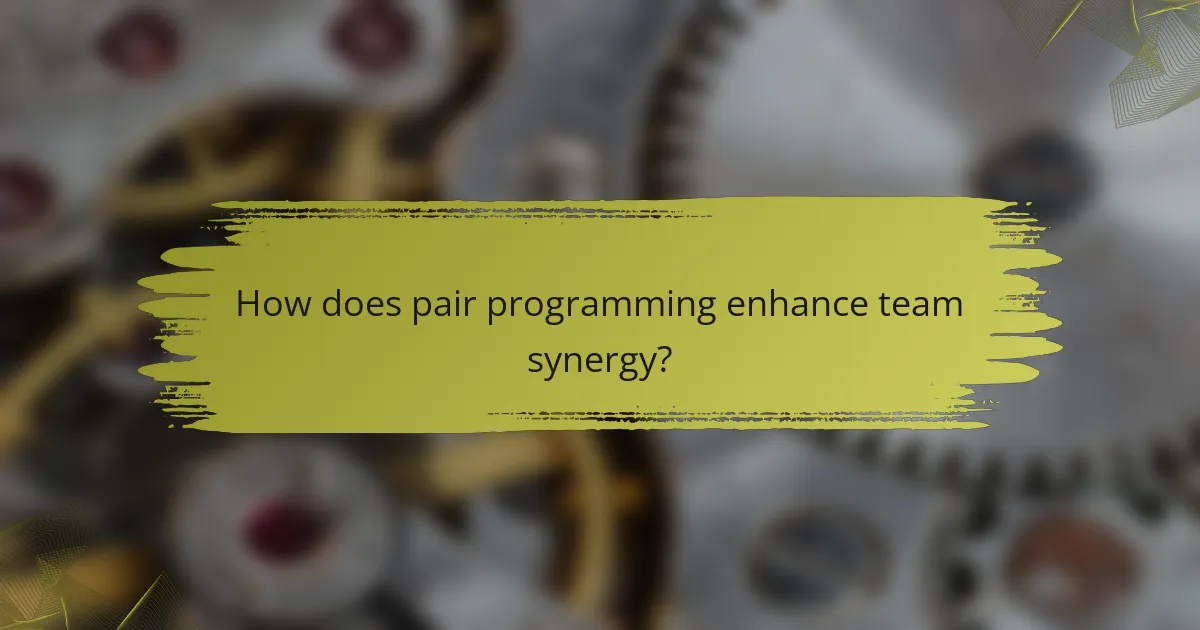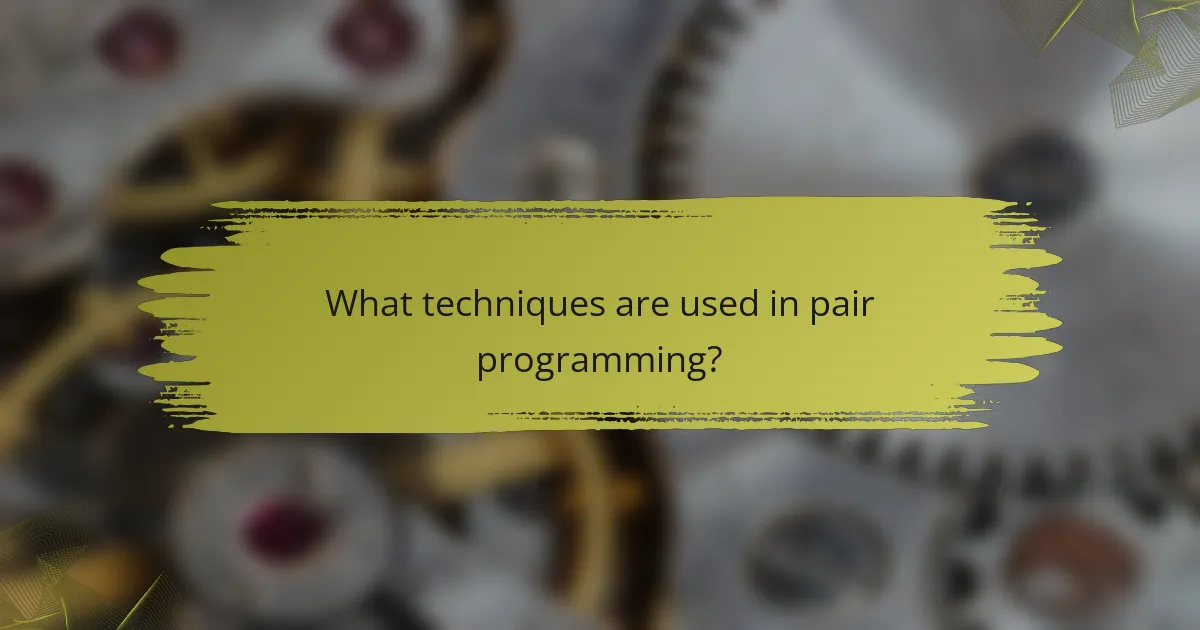Pair programming is a collaborative coding technique that brings together two developers to work on the same task, resulting in improved code quality and enhanced problem-solving capabilities. This method not only fosters better communication and teamwork but also allows developers to leverage each other’s strengths, ultimately creating a more cohesive and efficient coding environment.

What are the benefits of pair programming?
Pair programming offers numerous advantages, including improved code quality, enhanced collaboration, and faster problem-solving. By working closely together, developers can leverage each other’s strengths and minimize errors, leading to more efficient and effective coding practices.
Improved code quality
Pair programming significantly boosts code quality by allowing two developers to review each other’s work in real-time. This collaborative approach helps catch bugs early, ensuring that code adheres to best practices and standards. As a result, the final product is often cleaner and more maintainable.
Moreover, the presence of a second pair of eyes encourages adherence to coding standards and reduces the likelihood of introducing technical debt. Teams can implement coding conventions more consistently, leading to a more uniform codebase.
Enhanced team collaboration
Working in pairs fosters a culture of collaboration, as developers must communicate effectively to solve problems together. This interaction not only strengthens relationships but also builds trust among team members, which is essential for successful project outcomes.
Additionally, pair programming encourages diverse perspectives, as each developer brings unique insights and experiences to the table. This diversity can lead to innovative solutions and a more robust development process.
Faster problem-solving
Pair programming accelerates problem-solving by allowing two minds to tackle challenges simultaneously. When one developer encounters a roadblock, the other can provide immediate assistance, often leading to quicker resolutions than if working alone.
This collaborative effort can reduce the time spent debugging and troubleshooting, as both developers can brainstorm solutions and explore different approaches in real-time. As a result, projects can progress more swiftly, meeting deadlines more effectively.
Knowledge sharing
Pair programming serves as an excellent platform for knowledge sharing among team members. As developers work together, they naturally exchange skills, techniques, and insights, enhancing the overall competency of the team.
This practice is particularly beneficial for onboarding new team members, as they can learn directly from experienced colleagues. Over time, this shared knowledge contributes to a more skilled and versatile development team.
Increased developer engagement
Engaging in pair programming can lead to higher job satisfaction and motivation among developers. The collaborative nature of this practice helps reduce feelings of isolation, making work more enjoyable and fulfilling.
Furthermore, the continuous feedback loop inherent in pair programming allows developers to see the immediate impact of their contributions, fostering a sense of ownership and accountability. This increased engagement often translates into better performance and lower turnover rates within teams.

How does pair programming enhance team synergy?
Pair programming enhances team synergy by fostering collaboration and improving communication among team members. This technique allows two developers to work together on the same task, leading to a more cohesive team dynamic and better problem-solving capabilities.
Strengthens communication skills
Pair programming requires constant dialogue between partners, which significantly enhances communication skills. Developers must articulate their thoughts clearly and listen actively to each other, facilitating a deeper understanding of the task at hand.
To maximize communication benefits, teams should establish norms for discussing ideas openly and constructively. This can include regular check-ins and feedback sessions to ensure everyone feels comfortable sharing their insights.
Builds trust among team members
Working closely together in pair programming builds trust, as team members rely on each other’s expertise and judgment. This trust is crucial for creating a supportive work environment where individuals feel valued and respected.
To cultivate trust, it’s essential to encourage vulnerability and openness. Team members should share their challenges and successes, which helps to strengthen relationships and foster a sense of belonging within the team.
Encourages diverse perspectives
Pair programming naturally brings together individuals with different backgrounds and skill sets, leading to a variety of perspectives on problem-solving. This diversity can spark innovative solutions that might not emerge in solo programming.
To leverage diverse viewpoints effectively, teams should rotate pairings regularly. This practice allows developers to learn from one another and encourages a culture of inclusivity and collaboration.

What techniques are used in pair programming?
Pair programming employs various techniques to enhance collaboration and code quality. The most common methods include the Driver-Navigator model, Ping-Pong pairing, and Strong-style pairing, each offering unique approaches to teamwork and problem-solving.
Driver-Navigator model
The Driver-Navigator model is a foundational technique in pair programming where one person, the Driver, writes the code while the other, the Navigator, reviews each line and offers suggestions. This division of roles allows for focused coding while ensuring that the Navigator can catch potential errors and provide insights.
To implement this model effectively, it’s crucial to switch roles regularly, typically every 15 to 30 minutes. This keeps both participants engaged and helps distribute knowledge evenly across the team. A common pitfall is allowing one person to dominate the session, which can lead to disengagement and missed learning opportunities.
Ping-Pong pairing
Ping-Pong pairing is a dynamic technique where partners alternate roles frequently, switching between Driver and Navigator after completing a task or a set of tasks. This method encourages both participants to contribute equally and fosters a sense of shared ownership over the code.
To make the most of Ping-Pong pairing, set clear objectives for each coding session and ensure both partners are familiar with the codebase. A potential drawback is the risk of losing focus if the partners do not communicate effectively about their progress and next steps.
Strong-style pairing
Strong-style pairing emphasizes the Navigator’s role by requiring them to dictate the code that the Driver writes. This technique ensures that the Navigator is actively engaged and responsible for the quality of the code being produced, promoting a deeper understanding of the coding process.
When using strong-style pairing, it’s essential for the Navigator to articulate their thoughts clearly and for the Driver to ask questions if they are uncertain. This approach can lead to higher quality code and better learning outcomes, but it may require more time initially as both partners adjust to the communication style.

What tools facilitate pair programming?
Several tools enhance the pair programming experience by enabling real-time collaboration and code sharing. These tools allow developers to work together seamlessly, regardless of their physical location, fostering better communication and productivity.
Visual Studio Live Share
Visual Studio Live Share is a powerful extension for Visual Studio and Visual Studio Code that allows developers to collaborate in real-time. It enables participants to share their coding environment, including files and debugging sessions, without needing to clone repositories or set up complex environments.
Key features include the ability to edit code simultaneously, share terminals, and even debug together. This tool is particularly beneficial for teams that already use Visual Studio products, as it integrates smoothly into their existing workflows.
Tuple
Tuple is designed specifically for remote pair programming, offering a streamlined experience for developers. It provides low-latency screen sharing and allows users to control each other’s screens, making it easy to collaborate on coding tasks.
Tuple’s interface is minimalistic, focusing on the essentials to reduce distractions. It also includes voice chat and video capabilities, which help maintain a personal connection during remote sessions. This tool is ideal for teams that prioritize a smooth and interactive coding experience.
CodeTogether
CodeTogether is a versatile tool that supports pair programming across various IDEs, including Eclipse, IntelliJ, and VS Code. It allows multiple developers to join a shared coding session, enabling them to edit and run code collaboratively.
One of its standout features is the ability to host sessions without requiring participants to install any software, making it accessible for teams with different setups. CodeTogether also supports voice and video chat, enhancing communication during coding sessions. This flexibility makes it a great choice for diverse teams working on complex projects.

What are the prerequisites for effective pair programming?
Effective pair programming requires a few key prerequisites to ensure success. These include clear project goals, compatible skill levels among team members, and an open-minded team culture that fosters collaboration and communication.
Clear project goals
Establishing clear project goals is essential for effective pair programming. When both programmers understand the objectives, they can focus their efforts on achieving specific outcomes, which enhances productivity. Goals should be well-defined, measurable, and communicated to all team members to align their efforts.
For example, if the goal is to complete a feature by a certain deadline, both programmers should know the requirements and the timeline. This clarity helps avoid confusion and ensures that both participants are working towards the same end result.
Compatible skill levels
Having compatible skill levels among team members is crucial for effective pair programming. When one partner is significantly more experienced than the other, it can lead to frustration or disengagement. Ideally, partners should have complementary skills that allow them to learn from each other while contributing equally to the task.
A common approach is to pair a more experienced developer with a less experienced one, but both should have a foundational understanding of the project’s technology stack. This balance encourages knowledge sharing and fosters a collaborative learning environment.
Open-minded team culture
An open-minded team culture is vital for the success of pair programming. Team members should feel comfortable sharing ideas, asking questions, and providing constructive feedback. This culture promotes trust and encourages collaboration, which are essential for overcoming challenges during the programming process.
To cultivate an open-minded atmosphere, teams can hold regular check-ins to discuss progress and obstacles. Encouraging a mindset of experimentation and learning from mistakes can significantly enhance the effectiveness of pair programming sessions.

How to measure the success of pair programming?
Measuring the success of pair programming involves evaluating various performance metrics and team dynamics. Key indicators include code quality, productivity, and team satisfaction, which can provide insights into the effectiveness of this collaborative approach.
Code review metrics
Code review metrics are essential for assessing the impact of pair programming on code quality. These metrics typically include the number of defects found during reviews, the time taken to complete reviews, and the overall quality of the code produced. Tracking these factors can help teams identify areas for improvement.
For example, a decrease in defects over time may indicate that pair programming is enhancing code quality. Teams can also measure the average time spent on code reviews, aiming for a balance that ensures thoroughness without causing delays. A common heuristic is to keep review times within a range of 30 to 60 minutes per session.
Additionally, gathering feedback from team members about their experiences with pair programming can provide qualitative insights. Regular surveys or informal check-ins can help gauge satisfaction levels and identify any challenges faced during the process, allowing for adjustments to improve collaboration.



